Yellow Cake with Chocolate Frosting
This is the yellow cake of dreams. Perfect for celebrating birthdays, graduations, or simply getting through a tough week. The crumb is tender and moist, the chocolate frosting thick, luxurious, and slathered on generously. If you’re nostalgic for an updated version of classic yellow cake, this one hits all the right notes.
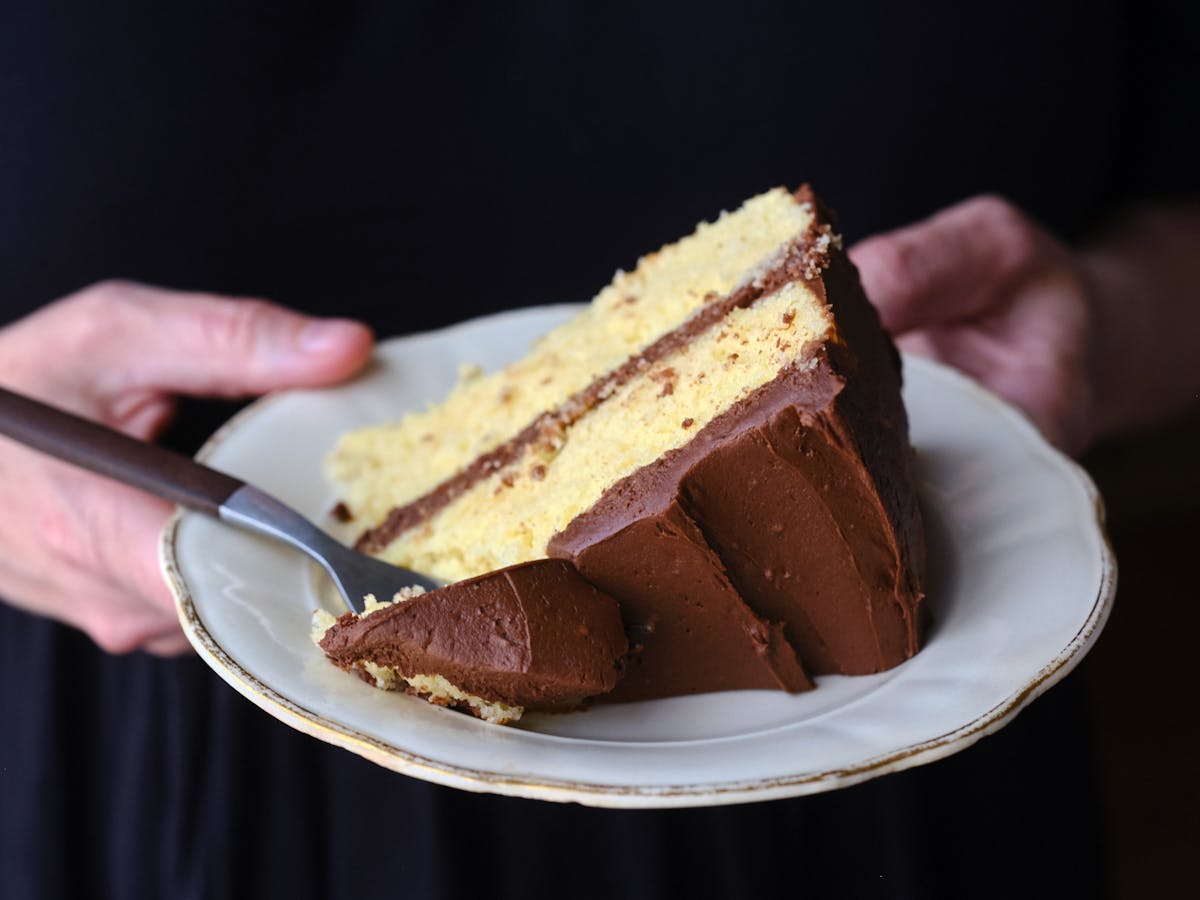
My birthday cake of choice is yellow cake with chocolate frosting. Generous with the frosting please, but not completely over the top. You’re looking at my go to. It checks all the boxes - classic, nostalgic, and tender cake layers covered with substantial, deep, thick, chocolate frosting. The frosting is mixed with enough salt to balance out the sweetness, and a good percentage of cream cheese. I resisted the urge to add sprinkles here, but it’s a cake that certainly welcomes them.
Yellow Cake: Technique
There are a number of ways to approach yellow cake, but I’m stuck on the following method for a few compelling reasons. First, because it makes a knockout cake. Second, I can mix the cake batter by hand if I want, without pulling a stand mixer onto the counter. A forever goal of mine. The most common yellow cakes have you cream butter and sugar together and proceed from there. Alternately, Rose Levy Beranbaum popularized a reverse-creaming method in The Cake Bible (1988) where you beat softened butter directly into dry ingredients. Both are great, both methods love a stand mixer. I started taking a third approach when mixing cake batter to bake in our little Airstream oven. Everything in that situation had to be mixed by hand, so I approached cake making more like mixing a pancake batter than anything else. Egg whites were whipped and folded in at the last minute, butter was melted instead of creamed and the result was lofty, rich, beautiful, moist cakes. That’s what you’ll see in today’s recipe.
Yellow Cake: Ingredients
I suspect many of you have most of what you need to make a wonderful yellow cake in your pantry right now. There’s nothing wild going on here, but I have a couple notes related to a key ingredients if you want to take a deeper dive.
- Cornstarch: A lot of cake recipes call for cake flour. It is lower in protein and yields a nice, desirable, tender cake crumb. I rarely buy cake flour, but always keep unbleached all-purpose flour on hand. I use a little trick here to drop the protein in my all-purpose flour by cutting it with a bit of cornstarch. It’s a technique I love to use in my favorite waffle recipe as well - and they’re THE BEST. Pinky swear.
- Cocoa: The cocoa powder in this recipe brings the chocolate color and flavor to the cream cheese spiked, buttercream frosting. Seek out 100% cocoa and experiment with different types. Ghirardelli 100% cocoa powder is readily available, and I’ve had good results using it. Guittard has a number of wonderful cocoa powders and if I see one of those, that’s what I’ll buy. You can go with Dutched cocoa or natural. Experimenting with your cocoa powder is a way to personalize your frosting, so experiment! Find one you love, or make a blend.
- Powdered Sugar: You’re going to make a big bowl of frosting for this cake. Ideally you should sift the powdered sugar for the silkiest frosting, but if I’m being honest, sometimes I’m too lazy. I didn’t bother sifting for my most recent cake, pictured here, and if you don’t mind a homemade looking cake, you can skip sifting as well.
- Eggs: Yellow cake often calls for eggs plus added egg yolks. The extra yolks add yellow to the cake along with richness and some density. I like my cake a shade lighter in texture, so I tend to go with three eggs total - with no added yolks.

Make Ahead Strategy
If you want to make components of this cake ahead of time, I suggest the following.
- To bake cake layers one day ahead: allow baked cake layers to cool completely, wrap well in plastic and frost the next day.
- To bake cake layers more than one day ahead: Bake, cool completely, wrap in plastic wrap and bag, freeze for up to a few weeks. Bring to room temperature before frosting.
- To make frosting up to a few days ahead of time: mix frosting and refrigerate until ready to use. Allow to come up to room temperature, mix until billowy and spreadable adding tiny splashes of milk or buttermilk to loosen the frosting up a bit if needed.
Yellow Cake Variations
- Four Layer Yellow Cake: You will have plenty of frosting to use if you want to slice each of the two cakes in half horizontally to make four thin layers. It makes a slightly taller and more elaborate cake.
- Confetti Yellow Cake: fold 2/3 cup (or more if you love them!) rainbow sprinkles into cake batter along with the last of the whipped egg whites. Save some extra sprinkles for the top of the cake as well!
- Citrus Yellow Cake: add the zest of an orange or two lemons to the wet ingredients. Orange in particular goes beautifully with the chocolate in this cake.
A Few Key Steps & Tips in Photos
Here's what a few of the steps in making this cake look like in photos.

Folding whipped egg whites into the cake batter, pictured above. Keep folding until you can no longer see those white streaks while maintaining as much volume as possible.
I love my cake pans, but a key to success is preparing them well with butter, parchment, and flour. A prepared cake pan is pictured above with cake batter. Ready to bake!
If you're nervous about getting cakes out of pans, the key is good preparation of the pans before baking. After baking, allow the cakes to cool a bit. They will shrink away and pull in from the sides (above). Gently run a small offset spatula around the cake pan to release any stuck bits and proceed from there.
This recipe doesn't skimp on frosting. You'll have enough to divide your two layers into four if you like. Try to get your cake layers as level as possible (see below), this recipe doesn't typically dome much for me, but I always arrange the layers "belly" to "belly" resulting in a super flat cake top.
More Cake Recipes
- Chocolate Devil’s Food Cake
- Flourless Chocolate Cake
- Glazed Lemon Cake
- Coconut Rum Cake
- Coffee Cake
- No Bake Chocolate Cake
- all baking recipes
Yellow Cake with Chocolate Frosting
I love to make this cake with almond extract. That said, please use vanilla extract if that is what you keep on hand. Either way you’ll have a delicious cake, the latter simply results in a more traditional yellow cake. For the frosting, seek out 100% cocoa (or cacao powder), it can be Dutched or natural.
- 3 eggs, separated, room temperature
- 2 cups / 400g granulated sugar, divided
- 1 cup / 225g buttermilk, room temperature
- 10 tablespoons / 145g unsalted butter, melted but not hot
- 3 tablespoons extra virgin olive oil
- 1 tablespoon vanilla extract or almond extract
- 2 1/4 cup / 280g unbleached all-purpose flour
- 1/4 cup cornstarch
- 1/4 teaspoon baking soda
- 1 1/4 teaspoon baking powder
- 1 teaspoon fine grain sea salt
- 1 1/2 cups unsalted butter, room temperature
- 8 ounces / 228g cream cheese, room temperature
- 1 1/2 cups / 140g cocoa powder
- 1 tablespoon vanilla extract or almond extract
- 7 cups / 770g powdered sugar
- 1 teaspoon fine grain sea salt
- 2-4 tablespoons buttermilk (or milk)
-
Butter two 9-inch round cake pans, line each bottom with parchment paper, butter the paper, and flour the pans.
-
Place oven racks in the center and pre-heat to 350°F / 176°C.
-
Whisk the egg whites in a mixing bowl (use an egg beater or electric mixer) until soft peaks begin to form. Gradually add 1/4 cup / 50g of the sugar and continue to mix until glossy, stiff peaks form - another minute or two. Set aside.
-
In a medium bowl, whisk together the buttermilk, melted butter, egg yolks, olive oil, and extract. Set aside.
-
In a large mixing bowl whisk together the remaining 1 3/4 cup sugar, flour, cornstarch, baking powder, baking soda, and salt. Mix well for 15 seconds or so. Gradually add the buttermilk mixture while stirring. Keep going until everything is just uniform.
-
Add half of the whipped egg white mixture to the cake batter and use a spatula to mix them in - this will loosen up the batter. Add the remaining egg whites and fold in until there are no visible white streaks left.
-
Divide the batter equally between the two prepared cake pans. Tap on the counter to loosen any bubbles, then bake for roughly 20 minutes, or until a cake tester inserted into the center of the cakes comes out clean. Rotate pans halfway through to ensure even baking.
-
Allow cakes to cool in pans on a wire rack for 15 minutes. Remove cakes from the pans and allow to cool on racks (or refrigerator) completely before frosting. Chilling them in a refrigerator makes them easier to slice into layers & frost, ideally using an offset spatula. While the cakes are cooling, mix up the frosting.
-
To make the chocolate frosting, beat the butter until creamy. You can do this by hand or with a stand mixer. Add the cream cheese and beat until combined, scraping the sides of the bowl along the way.
-
Add the cocoa powder and extract and mix on low if you're using a stand mixer. Drape your mixer with a clean towel to keep the cocoa powder in the bowl, if needed. Continue by adding 1/4 of the powdered sugar, mixing, and repeating until all the powdered sugar has been incorporated and the frosting is uniform in appearance and billowy. Add the buttermilk 1 tablespoon at a time until the consistency is to your liking. You want it thick, but spreadable. So it glides across the cake and doesn’t catch and tear.
-
First thing, my yellow cakes don’t typically dome, but every oven is different! If yours did, just trim the dome so your cake layers are perfectly flat. Or as close as possible. I like to use a serrated bread knife for this.
-
Place one layer of the cake on a platter or equivalent. Place strips of parchment around the base if you want to keep the platter clean. Spread a generous layer of frosting across the top and all the way to the edge. Top with the second layer, pressing gently to establish a connection and good structure. Finish by frosting the sides and top. Remove the parchment strips. Enjoy!
Note: Because of the cream cheese in the frosting, if it is going to be more than a couple hours, you should refrigerate this cake. Bring it up to room temperature before serving.
Serves 12.



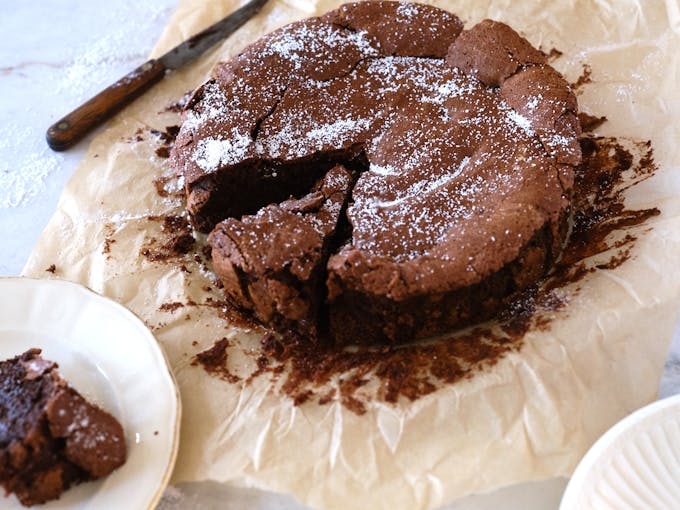
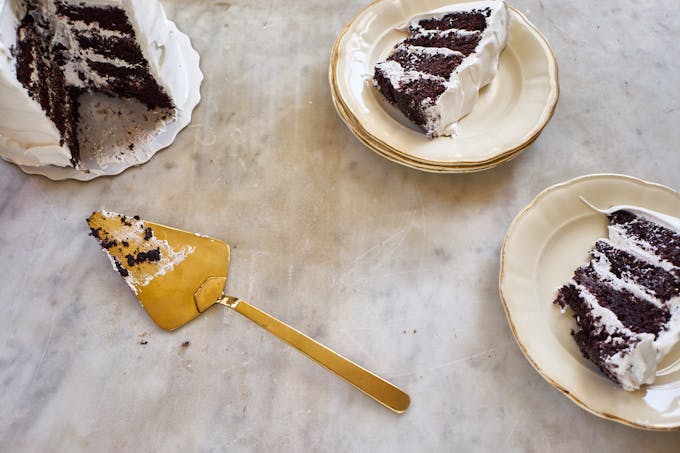
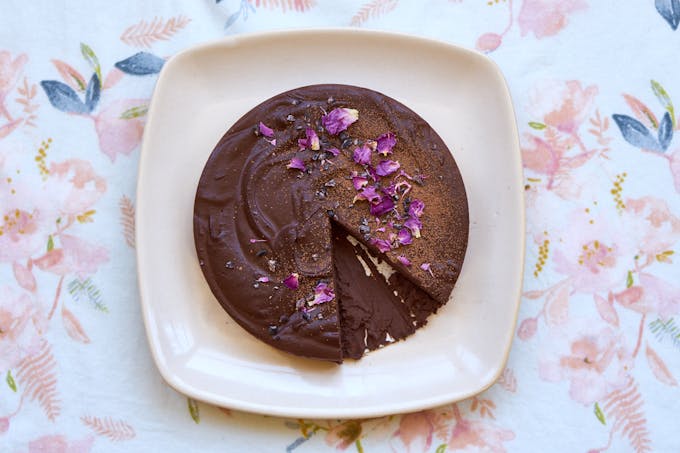
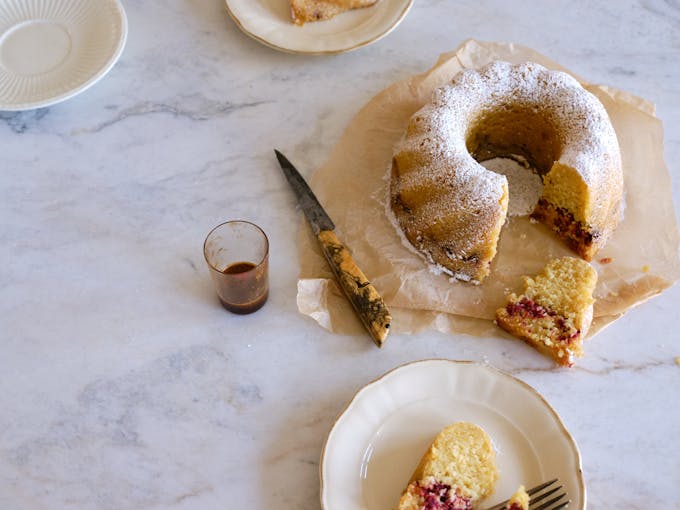
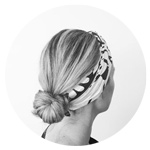
Post Your Comment